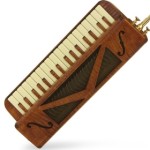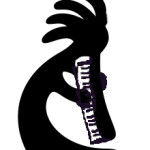A new piano and melodica video
Tagged: piano jazz yamaha
- This topic has 38 replies, 8 voices, and was last updated 8 years, 12 months ago by
 Kevin.
Kevin.
-
AuthorPosts
-
April 19, 2015 at 5:51 am #4741
 OfirParticipant
OfirParticipantLowboy, you’re absolutely right.
I missed the whole thread (seen just the opener), and stepping in now.April 20, 2015 at 12:51 am #4747 Stuart GoodallParticipant
Stuart GoodallParticipantI wonder if participants consider the “limitations” of the free reed as a sound generator, when considering the most appropriate melodica for the given music (or, most appropriate music for the melodica)? When the French harmonium was developing (C1860) there were many innovations (like percussion, where the reed was struck mechanically as well as blown) that were attempts to modify (improve) the sound and generally limited tone. I once owned a colossal American organ which essentially attempted the same thing through banks of octave and sub-octave reeds. The point is, though – you are never far away from the accordion! It’s gonna be the same deal, whether you have a harmonica, a melodica, an accordion or a harmonium: the sound-world will be that of the free reed and its particular harmonic fingerprint. Thus, just as the saxophone failed to end up as part of the modern orchestra, but found a home in jazz, so it shouldn’t be expected that the melodica is going to achieve usefulness as (for example) a classical voice: it won’t have the brilliance of a trumpet, or the woody richness of a clarinet, or the poetic quality of the flute. It does, though, have its own special, expressive sound world, and is a great “folk” instrument, again like the sax. The big advantage over the accordion, for the melodica, is the breath control and extension of the body – a real bonus for keyboard musicians looking for more expressivity that isn’t achieved electronically. Whew! (And I hope this is on the right thread.)
Further thought – yes, of course, that breathing contact is a part of the harmonica, too. But key thing about the melodica is the keyboard. Possible to play almost anything. Having said that, a harmonica genius like Toots Thielemans doesn’t seem too limited by his instrument!
April 20, 2015 at 1:06 am #4748 Alan BrintonParticipant
Alan BrintonParticipantToots is a genius, and I guess it would be right to say that he transcends his instrument and is one of the really great Jazz players, in my opinion. Do you know Julian Jackson’s album “I Can’t Get Started,” Stuart? I find him easier to play along with to try to get something like that sound. Do you know Hermeto Pascoal? He makes anything into a musical instrument, a pool of water, even a glass of beer. And the melodica, for anyone who has doubts about that.
April 20, 2015 at 11:39 am #4755 LowboyParticipant
LowboyParticipantStuart,
Insightful comments you have there. I have several insights to add but I am in Portland, Maine, for the weekend without a computer so I cannot write easily. I will add some thoughs when I get back.
But I will say that because of its small size, the closeness of the reeds to the players tongue and mouth, and the ability to modulate the sound acoustically with infinitely variable hand and finger movements, the harmonica is the most expressive free reed instrument.
Daren, these principles deserve some thought as you brainstorm melodica design.
Lowboy
April 26, 2015 at 7:55 pm #4833 LowboyParticipant
LowboyParticipantHi Stuart et al.,
The following is all bull that I believe, wrong or right. Let’s call this an editorial.
When Hohner started building the HM-926, HM-927, and button melodicas in the early 60s (I know Alan will correct me if I am wrong), they were building high quality instruments that sounded really nice.
These instruments, so the story goes, were for children, and the goal was ease of use. There was really no other reason to build a melodica except “ease of use” as we already had the much more expressive harmonica (but the harmonica takes years to master). We also had the accordion (but accordions are expensive and big and much more difficult to master than a melodica). So Hohner built a “harmonica” that was easy to learn and play, called it a melodica, and opened up a whole new market in education.
In making the melodica easy to learn and play, the expressiveness of the foundational instrument, the harmonica, was lost.
The tremendous expressiveness, simplicity, and portability of the harmonica is the reason why millions of harmonicas have been manufactured EVERY YEAR since the 1800s. Millions. The harmonica is found in jazz, folk, Americana, blues, roots, rock, popular music, world music (I imagine), and some “pops” symphony orchestras and serious composers have use it. Again, Alan please feel to correct me if I throw too much bull here.
In my opinion, the lack of expressiveness of the melodica is why it remains in obscurity, with about 1 in 10 adults even feigning they know what a melodica is (based on my experience).
The melodica has not become mainstream because it is not sufficiently expressive. It is, as Stuart says, “limited to the sound of free reeds” but without the expressiveness of the harp. Professional musicians have better choices.
We should note that in the hands of an expert player, the melodica can at least approach the expressiveness of the accordion and produce beautiful music.
Alan, is my bull factor still acceptable?
Quetscher and I and others are working towards extracting expressiveness from the instrument, and that could bring it to a new level of popularity. When you listen to Quetscher’s Godfather Theme, the last verse with note bending just comes alive compared to the previous verses; and immediately everyone wanted to know how he was bending notes on his Vibrandoneon.
My first priority in a dream melodica? Expressiveness above all else.
If Daren can combine the beautiful tone of the high-end melodicas and the expressive capability of my two-bit Hohners (said with great affection), then that is a melodica that could change the history of the melodica.
Regards,
Lowboy
April 26, 2015 at 10:58 pm #4834 Alan BrintonParticipant
Alan BrintonParticipantMy bull detector isn’t going off. What you’re saying seems right to me. I got out my first generation Suzuki A-25 (Study-25), the one before the Study-25 you have, and have been playing it. This is one of my favorites. There’s a world of difference between it and, say, the early 60s Hohner Piano 26. But it is also distinctive among Suzukis. Suzuki did a lot of experimentation, especially during the 1960s and early 70s and produced a lot more different and distinctive models than either Hohner or Yamaha. But as you know, Lowboy, no two of the vintage Hohner models have the same kind of sound. And then there’s the Clavietta, of course. So there are a lot of different kinds of sounds and kinds and degrees of expressiveness to be found among vintage melodicas. The proliferation of Chinese melodicas (including the recent Hohner models and plastic Suzukis) has unfortunately been moving us in another direction, toward a less expressive generic melodica sound. I know I’m not saying anything that Melodica Worlders don’t already know.
The expressiveness of a musical instrument is inversely proportional with how easy it is to play. Is this a true general principle?
April 27, 2015 at 7:31 pm #4846 QuetscherParticipant
QuetscherParticipantLowboy, this is a great classification of the melodica between the harmonica and the accordion, technically as well as historically.
“We should note that in the hands of an expert player, the melodica can at least approach the expressiveness of the accordion and produce beautiful music.” I’d even say that it can be superior in expressivity due to the fact that you can add the advantages of blowing to your playing.
“When you listen to Quetscher’s Godfather Theme, the last verse with note bending just comes alive compared to the previous verses.” I’d only half agree with that because what made the last verse more animated than the others (bending plus a more jazzy articulation) will not suit each kind of music. You can for for example bring a tango to life with many techniques I used in the verses before, but bendings or jazzy articulation would kill the effect of hardness or harshness you need in tango.
“If Daren can combine the beautiful tone of the high-end melodicas and the expressive capability of my two-bit Hohners (said with great affection), then that is a melodica that could change the history of the melodica.” But no pressure, Daren!!!
April 29, 2015 at 4:42 pm #4890 LowboyParticipant
LowboyParticipantInteresting observation Alan about Suzuki being the “experimenter” during the early stages of melodica development. I think it paid off for them as they are my second favorite brand of melodicas. I like the metal trays, the solid construction, the rubber bladder, the really high soprano model, and their characteristic compact, but still rich, sound that often exhibits harmonica overtones. Lowboy
April 29, 2015 at 6:58 pm #4892 KevinParticipant
KevinParticipantThis is becoming a very interesting discussion about the expressiveness or lack thereof of the melodica.
I wonder if we shouldn’t move it to it’s own thread?I find it interesting those of you who think the melodica is inexpressive? I find it quite expressive. I think it might have to do with the perspective of our expectations.
The melodica is certainly limited in what sort of effects can be achieved compared to a harmonica but if you are coming from an organ background as I do, the ability to have breath control over volume of each note, tongue articulation of attack and note bending is a huge advantage over an organ where the pitch is fixed, any sort of volume swell is controlled imprecisely and rather mechanically by a foot pedal and articulation is really unknown.
Even the much acclaimed Hammond organ is rather flat and lifeless if the Leslie is shut off or you play it through it’s original speaker system.I’ve been lucky enough to have some brass instrument experience and really think the melodica is as expressive as any of the valve brass instruments perhaps more so since you can play chords and intervals.
I think where we do suffer is the large amount of players who simply blow into the melodica as if filling a balloon with no articulation or change in pressure.
If a player has a piano background and no real wind instrument experience they are used to controlling expression by finger pressure and speed which has no effect on the melodica. They see the keyboard and feel at home. So they blow harshly in one end and bang away at the plastic keys producing a rather unmusical and inexpressive performance. This coupled with the plastic construction and association with early music education causes the melodica to have an association with buffoonery in many people minds.The melodica has not become mainstream because it is not sufficiently expressive. It is, as Stuart says, “limited to the sound of free reeds” but without the expressiveness of the harp. Professional musicians have better choices.
Lowboy,
I’m going to challenge you on that one statement.
I think the failure to become mainstream has more to do with the fact that there was never or hasn’t yet been a bona-fide dedicated melodica playing star. The closest we have had is Augustus Pablo but he never quite broke into the mainstream.
Until there is a good-looking player making the talk-shows and festivals I don’t think it will matter how wonderful an instrument we come up with or how virtuosic a player. Till somebody makes playing the melodica sexy, I think we are going to always be a keyboardists or accordionists side instrument. -
AuthorPosts
- You must be logged in to reply to this topic.
